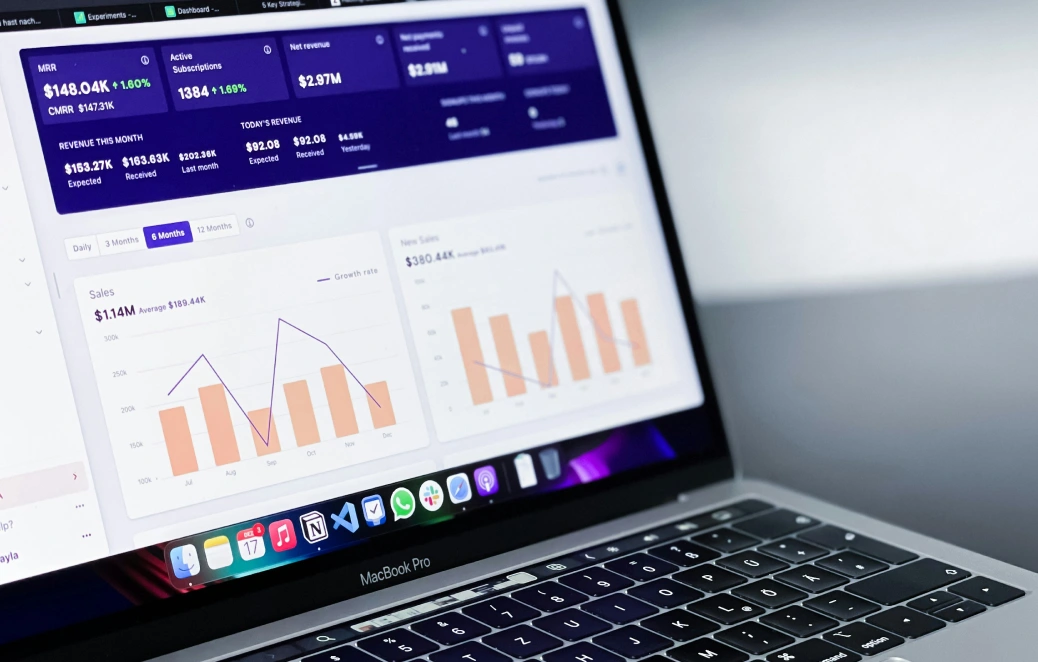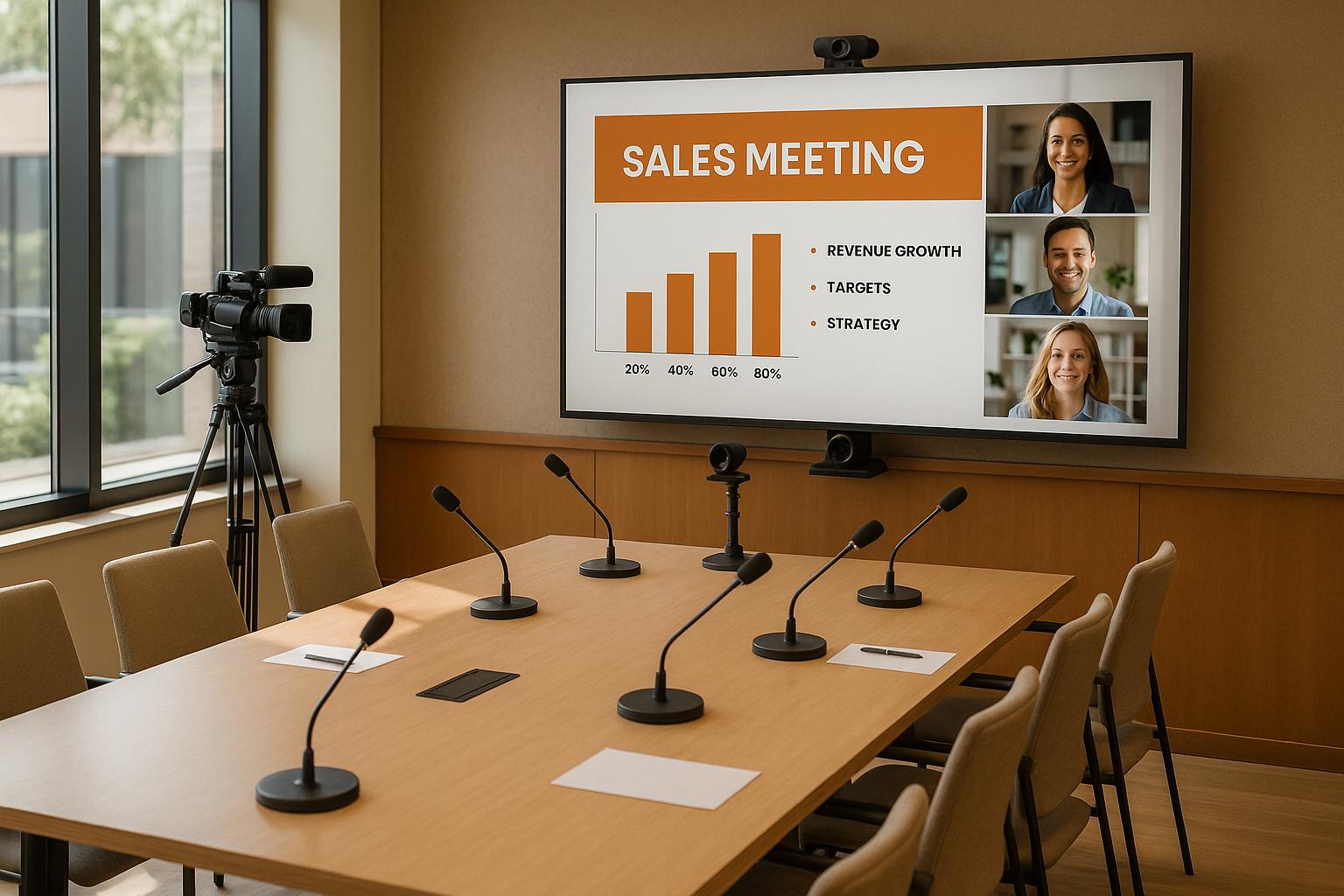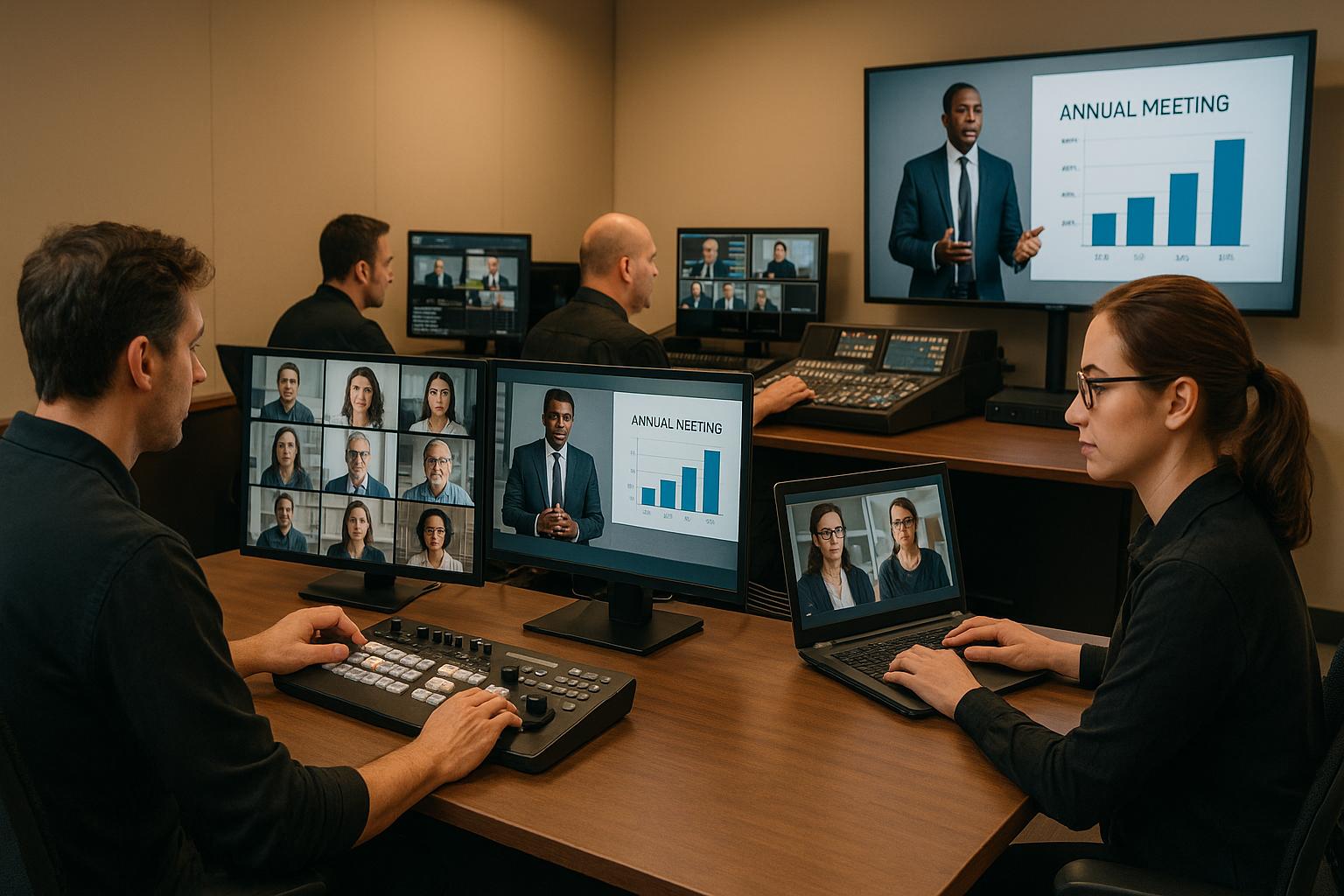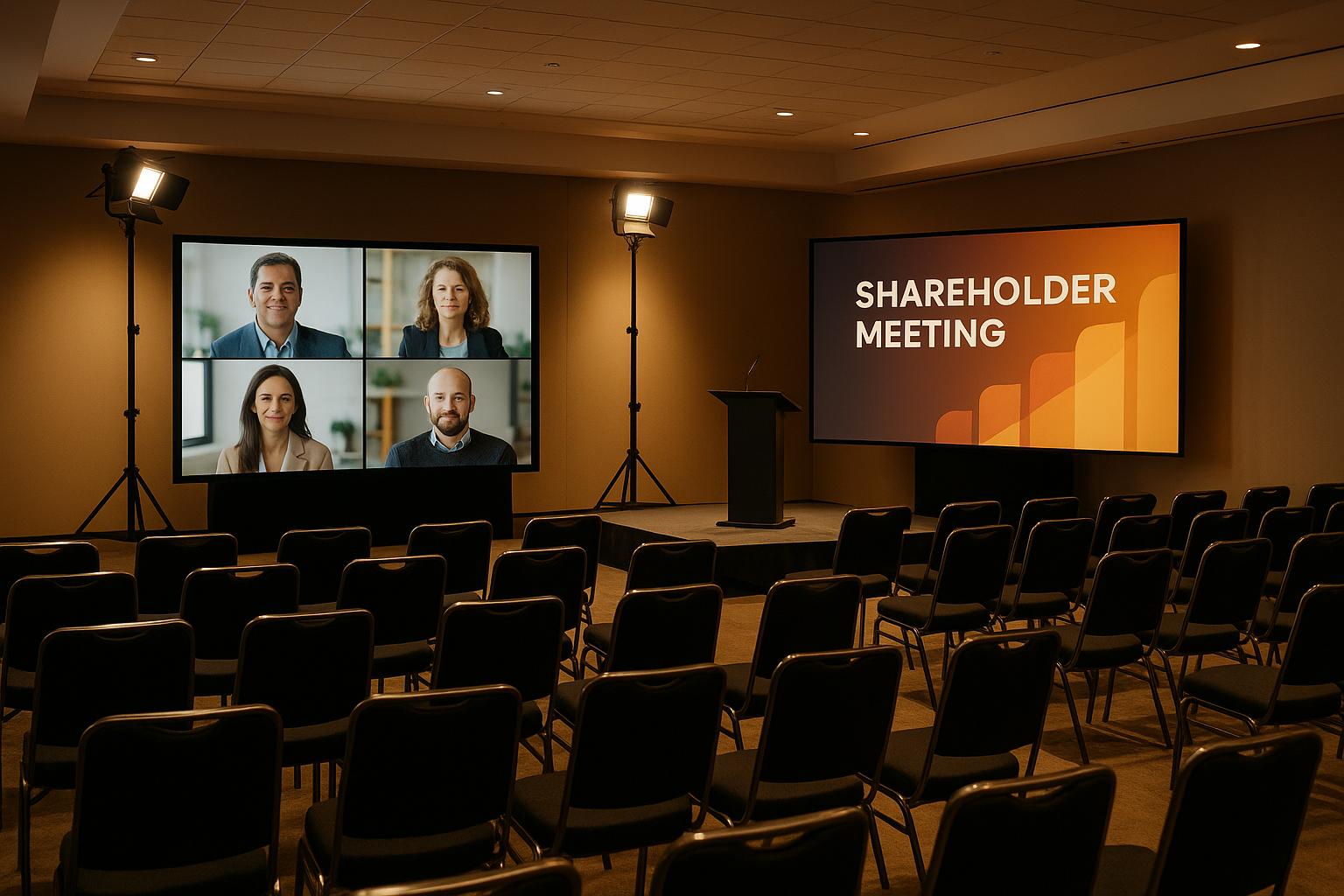Guide to Budget for Your Multi-Day Conference Technical Production

Chief Executive Officer

Planning a multi-day conference? Your technical production budget can make or break the event. From microphones to lighting, every detail matters. Here's what you need to know:
- Why it’s important: A solid technical production budget ensures smooth sessions, avoids disruptions, and keeps your event professional.
- What happens without it: Equipment failures, understaffing, and unexpected costs can derail your event and strain finances.
- Key cost areas: Audiovisual equipment, lighting, labor, and contingency funds are the main expenses to plan for.
- Budget tips: List all costs, get multiple quotes, keep 10–15% as a contingency fund, and track expenses in real-time.
Bottom line: A well-thought-out budget avoids surprises and ensures your conference delivers a high-quality experience for attendees.
How Much Does Event AV Cost – Whiteboard Wednesdays
Main Cost Categories in Technical Production
Managing your budget effectively is key to pulling off a successful conference. Let’s take a closer look at the different cost categories that play a major role in technical production. Having a clear understanding of these can help you plan smarter and avoid unnecessary surprises.
Audiovisual Equipment and Services
Audiovisual equipment is at the heart of any well-run conference. Think projectors, microphones, sound systems, screens, and mixing boards - all essential tools for smooth presentations. One big decision you'll face is whether to rent or buy this equipment. Renting often makes sense for most events since it gives you access to the latest gear without worrying about long-term maintenance or storage. However, for recurring events, buying might be worth considering.
Lighting and Staging
Lighting and staging do more than just illuminate a room - they set the mood and professionalism of your event. While many venues come with basic lighting, it’s often not enough to meet the technical demands of a conference. Upgraded lighting can improve the quality of presentations, enhance photos and videos, and create a more polished atmosphere. If your event involves video recording or live streaming, proper lighting becomes even more critical. Don’t forget to consider ambient lighting control to elevate the overall experience for attendees.
Labor and Staffing
Labor costs can quickly add up, especially as your event grows in complexity. You’ll need skilled professionals like AV technicians, stage managers, and production coordinators to ensure everything runs smoothly. Depending on your budget and needs, you can hire full-time experts or bring in freelancers for specific roles. For highly specialized tasks, hiring on a project basis can help you manage costs without sacrificing quality.
Contingency Planning for Unexpected Costs
No matter how well you plan, unexpected expenses will happen. That’s why it’s smart to set aside 10–15% of your budget as a contingency fund. Whether it’s renting backup equipment, dealing with last-minute venue changes, or handling weather-related issues, having this reserve can save you from financial headaches. Planning for the unpredictable is just as important as budgeting for the known.
Other Expenses You Should Include
Beyond the main categories, there are several additional costs that can sneak up on you. Temporary power setups, enhanced internet connectivity, and special effects are just a few examples. Don’t overlook event insurance, which is often required by venues and vendors to cover technical equipment and production liability. On top of that, factor in logistical expenses like transporting equipment, setup, and security. Addressing these details during the planning phase can help you avoid unpleasant surprises later.
How to Create a Technical Production Budget Step by Step
Crafting a technical production budget for a multi-day conference doesn't have to be overwhelming. By taking a structured approach, you can map out your technical needs while keeping expenses in check. Follow these steps to build a solid plan.
Define Your Event Scope and Technical Requirements
Start by outlining exactly what your event entails. Think about the number of days, expected attendance, and how many sessions will run simultaneously. These details will directly shape your technical needs and overall budget.
Next, assess the complexity of each session. Will you need basic setups with a microphone and projector, or are you planning for something more elaborate - like multi-camera productions, live streaming, or interactive displays? For instance, a keynote presentation might call for advanced lighting and large screens, while a smaller breakout session could get by with minimal equipment.
Don’t forget to evaluate your venue’s technical capabilities. Multi-day events often use various spaces, such as main auditoriums, breakout rooms, networking areas, and exhibit halls. Each space will have unique technical requirements. For example, the main stage might need professional-grade lighting and sound, while smaller rooms might only need a simple projector and speaker system.
Finally, identify any specialized needs, such as live streaming, recording, or engagement tools for audience interaction. Pinning down these details early will help you estimate costs more accurately and avoid surprises later.
List All Costs in Detail
Once you’ve nailed down your event’s scope, it’s time to break down every expense. Be thorough and format all costs in USD for consistency (e.g., $1,500.00).
Start with the big-ticket items like audiovisual equipment, lighting, and labor. Since prices can vary widely depending on specifications, get multiple quotes to ensure you’re paying competitive rates. Don’t forget to include costs for skilled labor, such as AV technicians and lighting designers.
Smaller expenses can add up quickly, so make sure to account for things like power distribution, cable management, internet access, transportation, and setup fees. These costs often depend on the venue’s infrastructure and the complexity of your technical setup.
By organizing all these details, you’ll have a clear picture of your budget needs and where adjustments might be possible.
Get and Compare Vendor Quotes
Armed with your detailed requirements, reach out to multiple vendors for quotes. Be specific about your needs to ensure the proposals you receive are accurate and comprehensive. Each quote should include equipment costs, labor fees, setup and breakdown charges, and any additional services.
When evaluating quotes, look beyond the bottom line. For example, one vendor might offer cheaper equipment but charge more for labor, while another might bundle services like backup equipment and on-site support into a single package. Bundled deals can often provide better value, so don’t hesitate to negotiate.
It’s also smart to ask vendors about their backup plans. Having spare equipment or emergency support can be a lifesaver if something goes wrong. Finally, request detailed timelines to account for any extra labor needed for complex setups.
Monitor and Update Your Budget During Planning
Your budget isn’t static - it should evolve as your plans take shape. Regularly review and update it, especially in the critical final weeks of preparation.
Document any changes and the reasons behind them. For instance, if you decide to add live streaming, note how this aligns with your event goals. This kind of tracking not only keeps your budget organized but also provides insights for future events.
Stay flexible with your budget categories. Savings in one area - like using the venue’s existing lighting - can free up funds to enhance other technical aspects. Use budgeting tools to track these adjustments and ensure you stay within your overall target.
Finally, establish clear rules for approving additional expenses. Keep your contingency fund separate and only dip into it for unexpected costs, not planned upgrades. If you do use it, update your budget accordingly to stay aware of the risks involved.
sbb-itb-ae35a94
Tools and Methods for Budget Optimization
Getting the most out of your technical production budget requires smart planning, the right tools, and a solid strategy. Experienced event planners know how to stretch their budgets without compromising on production quality. By incorporating these tools and techniques into your planning process, you can create a seamless and cost-effective event.
Budget Templates and Production Software
Spreadsheet templates continue to be a go-to tool for managing event budgets. Start by creating a detailed master template that includes categories like audiovisual equipment, labor, staging, and contingency funds. Add columns for estimated costs, actual quotes, and any variances. Be sure to format all amounts in USD (e.g., $2,500.00) for clarity and consistency.
For a more streamlined approach, consider modern event management software. Many platforms come with built-in budget tracking features that automatically calculate totals and generate reports in standard US formats. These tools can also help manage budget approvals, track vendor communications, and send automated reminders to keep everything on schedule.
If you're organizing a multi-day event, production software can be a game-changer. These tools assist with complex scheduling and resource allocation, often including cost-per-hour calculators for labor and equipment. This makes it easier to evaluate and compare different setup scenarios, ensuring you allocate resources efficiently.
Ways to Save Money on Technical Production
When it comes to cutting costs without sacrificing quality, focus on the elements that make the biggest impact. For example, invest in high-quality microphones and speakers, as audience members are far more likely to notice sound clarity than intricate lighting setups.
Here are some additional cost-saving strategies:
- Bundle services: Negotiate package deals for audiovisual and lighting services. This can help lower overall costs and simplify coordination.
- Stagger staffing schedules: Instead of having all technicians work at the same time, plan for sequential setups. This approach reduces labor costs while maintaining production quality.
- Use venue resources: Many venues offer basic audiovisual packages at competitive rates. While the equipment might not be top-of-the-line, it’s often sufficient for smaller sessions or breakout rooms. Save premium rentals for your main stage or high-profile presentations.
- Adopt hybrid solutions: Combine venue-provided projectors and screens with professional sound and lighting setups. This strikes a balance between cost savings and production quality.
- Book strategically: Schedule your event during off-peak seasons or weekdays to take advantage of lower rental rates.
Conclusion: Building a Balanced Technical Production Budget
After diving into the nuts and bolts of technical production costs and budgeting strategies, one thing is clear: flexibility is your greatest ally. A well-balanced budget doesn’t just align quality and cost - it also leaves room for the unexpected. This clarity ensures every decision supports your event’s goals without veering off course.
Smart planners treat their budget as a living document, adjusting it as new quotes, requirements, or challenges arise. This ongoing refinement helps avoid those unpleasant surprises that can throw even the best-laid plans into chaos.
Being adaptable is non-negotiable. Contracts with modification clauses and vendors who can scale their services are your safety net against cost overruns. As MIT Sloan Executive Education aptly puts it, "Businesses that aren't adaptable are stuck in their current state and unable to easily or affordably change to meet the conditions around them". This rings especially true for events, where last-minute changes - like a new speaker, a venue tweak, or upgraded tech - can quickly impact your finances.
To keep surprises manageable, build flexibility into every step of your planning. Negotiate contracts that allow adjustments, work with vendors who can adapt to your needs, and maintain relationships with backup suppliers. These measures ensure that unexpected costs don’t spiral out of control.
Key Points for Conference Planners
Here are some essential takeaways to guide your approach:
- Set clear priorities early on. Focus your budget on high-impact moments like keynote presentations and main stage events. For areas like breakout rooms or networking spaces, opt for simpler setups where production quality isn’t as critical.
- Keep 15–20% of your technical budget in reserve as a cushion for inevitable changes. Whether it’s extra microphones for a last-minute panel or backup equipment for system failures, having these funds can save the day.
- Track your expenses in real time with detailed spreadsheets or event management tools. Update your budget weekly during planning and daily during the event to catch potential overruns early enough to adjust.
- Partner with dependable suppliers who meet your standards and can adapt quickly to changes. Reliable vendors often shine under pressure and may offer better deals for future events.
- Plan for multiple scenarios. Be ready for changes in attendance, weather disruptions for outdoor elements, or tech issues. Contingency planning ensures you’re prepared for the unexpected.
- Consider professional event production services. Companies like Corporate Optics bring expertise that can help you avoid costly mistakes. Their established vendor relationships may even lead to better pricing, saving you money in the long run.
A balanced technical production budget isn’t about pinching pennies - it’s about spending strategically to create the best experience for your attendees while staying within your financial limits. The most successful events focus their resources on elements that directly enhance the audience experience and find creative ways to economize in less critical areas.
Ultimately, your budget should act as both a guide and a safety net throughout the entire event process. When faced with opportunities or challenges, use your priorities and contingency plans to make thoughtful decisions that align with your goals while keeping finances in check.
FAQs
Is it more cost-effective to rent or buy audiovisual equipment for a multi-day conference?
Deciding whether to rent or buy audiovisual (AV) equipment for your multi-day conference comes down to a few key considerations: how often you'll need the equipment, the complexity of your event, and your budget.
Renting is often the go-to choice for one-off or infrequent events. It keeps your initial costs manageable, gives you access to up-to-date technology, and usually includes perks like professional setup and troubleshooting.
Buying, however, can make sense if you host events regularly. While it involves a larger upfront cost and ongoing maintenance, owning the equipment could reduce expenses in the long run and even provide a resale option later.
Take a close look at your event schedule, technical requirements, and financial situation to decide which approach works best for your needs.
How can I plan for and manage unexpected costs when organizing a multi-day conference?
When planning a conference, unexpected costs can pop up when you least expect them. To stay ahead, start by setting aside a contingency fund - aim for 10–15% of your total budget. This extra cushion can help you handle last-minute expenses or emergencies without derailing your plans.
Stay on top of your spending by using real-time budget tracking tools or keeping a regularly updated spreadsheet. This way, you'll catch potential issues early and can adjust as needed. It's also smart to review every contract carefully. Look for details on costs related to staffing, overtime, or equipment, and ask for a detailed breakdown to avoid any surprise fees.
Lastly, have backup plans ready for key elements like equipment, labor, and essential services. Being prepared ahead of time can save you a lot of stress if things don't go as planned.
How can I make sure my vendors are prepared to handle technical issues during my multi-day conference?
To keep your vendors ready for any hiccups, ask them for a detailed plan to address technical issues. This plan should cover essentials like having spare equipment available - think extra microphones, cables, and backup laptops. Make sure they also have clear protocols in place for managing disruptions, including well-documented disaster recovery and business continuity strategies.
Stay in regular communication with your vendors and clearly outline expectations about backup procedures in your contracts. This way, everyone is on the same page and prepared to handle challenges, ensuring your event stays on track without unnecessary downtime.
Related Blog Posts









